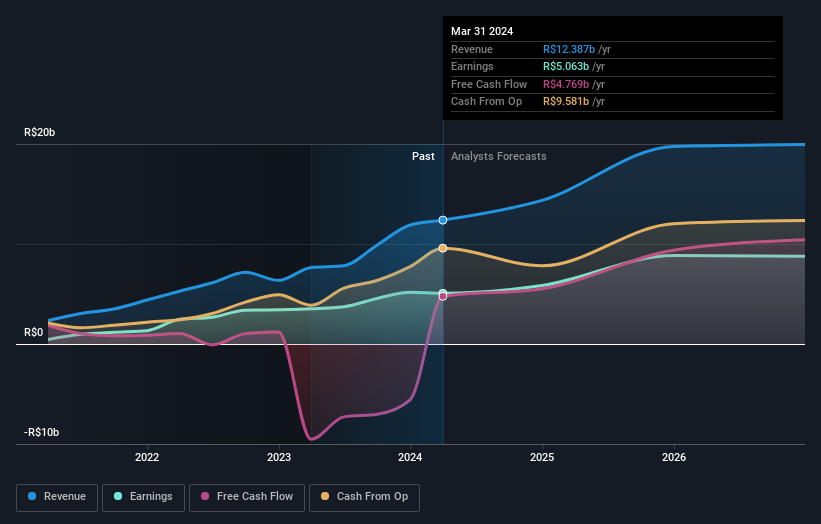- Brazil
- /
- Oil and Gas
- /
- BOVESPA:PRIO3
Prio S.A. Just Missed Earnings - But Analysts Have Updated Their Models

The quarterly results for Prio S.A. (BVMF:PRIO3) were released last week, making it a good time to revisit its performance. It was not a great result overall. Although revenues beat expectations, hitting R$3.2b, statutory earnings missed analyst forecasts by 17%, coming in at just R$1.24 per share. Earnings are an important time for investors, as they can track a company's performance, look at what the analysts are forecasting for next year, and see if there's been a change in sentiment towards the company. We've gathered the most recent statutory forecasts to see whether the analysts have changed their earnings models, following these results.
Check out our latest analysis for Prio

Taking into account the latest results, the consensus forecast from Prio's twelve analysts is for revenues of R$14.4b in 2024. This reflects a solid 16% improvement in revenue compared to the last 12 months. Per-share earnings are expected to soar 29% to R$7.78. In the lead-up to this report, the analysts had been modelling revenues of R$14.7b and earnings per share (EPS) of R$8.12 in 2024. The analysts are less bullish than they were before these results, given the reduced revenue forecasts and the small dip in earnings per share expectations.
Despite the cuts to forecast earnings, there was no real change to the R$65.46 price target, showing that the analysts don't think the changes have a meaningful impact on its intrinsic value. That's not the only conclusion we can draw from this data however, as some investors also like to consider the spread in estimates when evaluating analyst price targets. Currently, the most bullish analyst values Prio at R$82.00 per share, while the most bearish prices it at R$45.90. This shows there is still a bit of diversity in estimates, but analysts don't appear to be totally split on the stock as though it might be a success or failure situation.
Of course, another way to look at these forecasts is to place them into context against the industry itself. We would highlight that Prio's revenue growth is expected to slow, with the forecast 22% annualised growth rate until the end of 2024 being well below the historical 47% p.a. growth over the last five years. Juxtapose this against the other companies in the industry with analyst coverage, which are forecast to grow their revenues (in aggregate) 0.2% per year. Even after the forecast slowdown in growth, it seems obvious that Prio is also expected to grow faster than the wider industry.
The Bottom Line
The most important thing to take away is that the analysts downgraded their earnings per share estimates, showing that there has been a clear decline in sentiment following these results. They also downgraded Prio's revenue estimates, but industry data suggests that it is expected to grow faster than the wider industry. There was no real change to the consensus price target, suggesting that the intrinsic value of the business has not undergone any major changes with the latest estimates.
With that in mind, we wouldn't be too quick to come to a conclusion on Prio. Long-term earnings power is much more important than next year's profits. We have forecasts for Prio going out to 2026, and you can see them free on our platform here.
You can also view our analysis of Prio's balance sheet, and whether we think Prio is carrying too much debt, for free on our platform here.
New: Manage All Your Stock Portfolios in One Place
We've created the ultimate portfolio companion for stock investors, and it's free.
• Connect an unlimited number of Portfolios and see your total in one currency
• Be alerted to new Warning Signs or Risks via email or mobile
• Track the Fair Value of your stocks
Have feedback on this article? Concerned about the content? Get in touch with us directly. Alternatively, email editorial-team (at) simplywallst.com.
This article by Simply Wall St is general in nature. We provide commentary based on historical data and analyst forecasts only using an unbiased methodology and our articles are not intended to be financial advice. It does not constitute a recommendation to buy or sell any stock, and does not take account of your objectives, or your financial situation. We aim to bring you long-term focused analysis driven by fundamental data. Note that our analysis may not factor in the latest price-sensitive company announcements or qualitative material. Simply Wall St has no position in any stocks mentioned.
About BOVESPA:PRIO3
Prio
Engages in the exploration, development, and production of oil and natural gas properties in Brazil and internationally.
Undervalued with solid track record.
Similar Companies
Market Insights
Community Narratives



